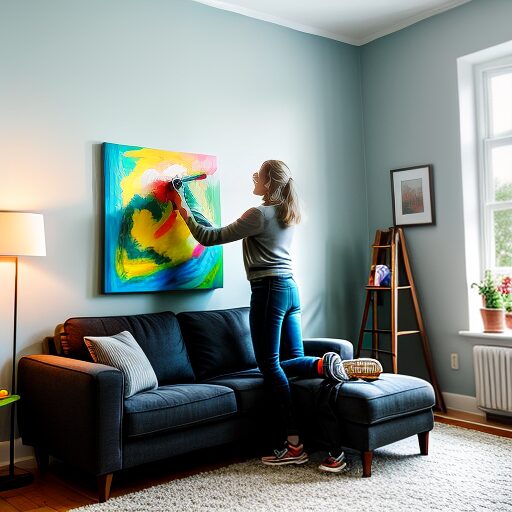Homeownership is a journey filled with both pride and responsibility, and one of the most fulfilling aspects of owning a home is the opportunity to personalize and maintain it through DIY projects. Whether you’re looking to spruce up your space, tackle minor repairs, or take on more ambitious renovations, DIY home projects are a fantastic way to enhance your living environment while saving money. In this post, we’ll explore some of the most common DIY home projects, offering tips and inspiration for both beginners and seasoned DIYers alike.
Here are some of the most common DIY home projects that homeowners often take on:
1. Painting and Repainting Rooms
One of the simplest and most impactful DIY home projects is painting. Whether you’re refreshing the look of your living room, adding a pop of color to a bedroom, or updating the trim throughout your home, painting is an affordable way to transform your space.
Tips for success:
– Prep is key: Before you start painting, ensure the walls are clean and free of dust or cobwebs. Repair any holes or cracks with spackle or joint compound, and sand the surfaces smooth.
– Use quality paint and tools: Invest in good-quality paintbrushes, rollers, and painter’s tape to get clean lines. High-quality paint will also give you better coverage, lasting results, and a more professional-looking finish.
– Consider finishes: Different finishes (matte, satin, eggshell, semi-gloss) can dramatically change the look of your room. Matte is great for hiding imperfections, while satin or semi-gloss finishes are easier to clean and more durable, especially in high-traffic areas or kitchens.
2. Installing Shelving
Adding shelving to your home can help maximize storage space and give your rooms a more organized, functional look. Whether you’re installing floating shelves in the living room, extra bathroom storage, or built-in shelving in your closet, this is a project that can be done in a weekend with the right tools. Shelving is a versatile DIY project that can increase both the functionality and style of your space.
Tips for success:
– Measure twice, cut once: Properly measuring the space where you intend to install the shelves is crucial. Consider factors like weight capacity and shelf depth to ensure they’re both practical and aesthetically pleasing.
– Choose the right material: Shelves can be made from wood, metal, or floating shelf brackets. Select a material that complements the room’s decor and supports the weight of the items you plan to place on them.
– Secure to studs: For maximum stability, always secure your shelves to wall studs, not just drywall. Use a stud finder to locate them and drill pilot holes before inserting screws.
3. Upgrading Light Fixtures
Lighting has the power to completely change the ambiance of a room. Changing out old light fixtures for more modern or energy-efficient options can immediately change the mood of a room. This DIY project is often simple, especially if you’re just swapping out one fixture for another, and can be done with minimal tools. For a more complex upgrade, such as installing recessed lighting or pendant lights, some basic electrical knowledge may be required.
Tips for success:
– Turn off power: Always turn off the power at the breaker box before working with any electrical components to ensure safety.
– Know your fixture sizes: Ensure the light fixture is appropriate for the size of the room. A fixture that’s too large can overwhelm the space, while one that’s too small might not provide enough light.
– Consider energy-efficient options: LED lighting is a great choice for saving energy and reducing your utility bills. Many modern LED fixtures also come in a variety of styles and can provide a long-lasting, cost-effective solution.
4. Laying Tile or Installing Backsplashes
Tiling is a popular DIY project, especially in kitchens and bathrooms. Installing a backsplash or laying new tile in a shower, floor, or around a sink can completely change the look of these spaces. This project may take some time and patience, but with the right preparation and tools, you can achieve professional-looking results without the need to hire a contractor.
Tips for success:
– Surface preparation: Make sure the surface you’re tiling is clean, smooth, and dry. You might need to apply a primer or bonding adhesive to ensure the tiles adhere properly.
– Tile layout: Plan your layout in advance by dry-fitting the tiles to minimize cuts and ensure symmetry. You can use tile spacers to maintain even grout lines between the tiles.
– Grouting: Once the tiles are set, use a rubber float to apply grout, pressing it into the spaces between the tiles. Be sure to wipe away excess grout before it hardens.
5. Building Custom Furniture
For DIY enthusiasts who enjoy working with wood, creating custom furniture pieces like coffee tables, bookshelves, or even bed frames can be a rewarding challenge. Not only can you tailor the design to your space, but you’ll also end up with unique, one-of-a-kind pieces. From bookshelves to coffee tables and even bed frames, this project allows you to customize the design and materials to match your exact style and needs.
Tips for success:
– Measure accurately: Precision is essential when building custom furniture. Make sure to take accurate measurements and follow plans or blueprints closely.
– Invest in the right tools: Basic tools like a circular saw, drill, and sander are essential for wood furniture projects. For more complex pieces, a table saw or miter saw may be necessary.
– Finish your pieces: Sand your furniture thoroughly to create a smooth surface, and apply a stain, paint, or varnish to protect the wood and enhance its appearance.
6. Gardening and Landscaping
A beautiful garden not only adds curb appeal but also creates a tranquil retreat right outside your door. Whether you’re planting a garden, creating a vegetable patch, or building a stone pathway, landscaping projects allow you to enjoy the outdoors while making your home more inviting.
Tips for success:
– Choose the right plants: Select plants that are well-suited to your local climate and soil conditions. Research sun and water requirements to ensure your plants thrive.
– Plan your layout: Think about the aesthetic you want to create, whether it’s a lush garden with flowering plants, a minimalist garden with clean lines, or a functional vegetable garden.
– Start small: If you’re new to gardening, start with a few plants or a small garden bed. You can expand over time as you gain confidence and experience.
7. Installing a New Faucet or Showerhead
Updating plumbing fixtures like faucets and showerheads is a great way to improve both the functionality and aesthetic of your kitchen or bathroom. New fixtures can improve water efficiency, reduce maintenance needs, and give your bathroom or kitchen a polished look. Many of these projects are relatively easy and can be done with basic tools, making them ideal for beginners.
Tips for success:
– Know your plumbing: Familiarize yourself with the type of plumbing system you have and the compatibility of the new fixtures with your existing setup. Some faucets may require a specific number of holes for installation.
– Use plumber’s tape: To avoid leaks, apply plumber’s tape to threaded connections when installing new faucets or showerheads.
– Don’t overtighten: While it’s important to secure the fixtures tightly, over-tightening can cause damage to the pipes or the fixture itself.
8. Repairing or Replacing Flooring
Flooring is one of the most high-impact aspects of home design, and it can be relatively simple to upgrade with DIY installation. If your floors are showing signs of wear, replacing or repairing them can give your entire home a facelift. Whether you’re installing hardwood floors, vinyl planks, or laminate, or even just fixing a few damaged tiles, this project will make a noticeable difference in the look and feel of your home.
Tips for success:
– Prepare the subfloor: Before installing any new flooring, make sure the subfloor is clean, dry, and level. For wood or laminate floors, ensure the area is free from debris to avoid imperfections.
– Consider floating floors: For beginners, consider floating floors (like vinyl plank or laminate), which don’t require glue or nails. These floors simply click into place, making them easier to install.
– Cutting tiles or planks: When working with tile or hardwood, you may need to make precise cuts to fit the edges of the room. Use a tile cutter or a jigsaw with a fine-tooth blade for cleaner edges.
____________________________________________________________________________________
By diving into these DIY home projects, you can not only improve the functionality and style of your home, but also develop valuable skills that will benefit you for years to come. Whether you’re sprucing up your living room with a fresh coat of paint, adding custom shelving, or installing new flooring, each project allows you to put a personal touch on your home while saving money and learning new techniques. The key to success is starting with manageable projects, ensuring you’re prepared with the right tools, and taking the time to do the job correctly. So, roll up your sleeves, gather your materials, and get ready to make your house feel more like home through the power of DIY!

